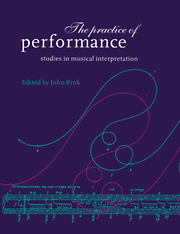Book contents
- Frontmatter
- Contents
- Preface
- PART ONE FUNDAMENTALS
- PART TWO STRUCTURE AND MEANING IN PERFORMANCE
- PART THREE PERFORMANCE AS PROCESS
- 9 Performance and analysis: interaction and interpretation
- 10 Analysis and the act of performance
- 11 The pianist as critic
- 12 Playing in time: rhythm, metre and tempo in Brahms's Fantasien Op. 116
- Index
12 - Playing in time: rhythm, metre and tempo in Brahms's Fantasien Op. 116
Published online by Cambridge University Press: 10 October 2009
- Frontmatter
- Contents
- Preface
- PART ONE FUNDAMENTALS
- PART TWO STRUCTURE AND MEANING IN PERFORMANCE
- PART THREE PERFORMANCE AS PROCESS
- 9 Performance and analysis: interaction and interpretation
- 10 Analysis and the act of performance
- 11 The pianist as critic
- 12 Playing in time: rhythm, metre and tempo in Brahms's Fantasien Op. 116
- Index
Summary
The growing literature on analysis and performance should be approached with caution by the enquiring performer: prolonged exposure might induce a state of confusion or despondency. Two contradictory tendencies characterise this literature: first, an authoritarian school of thought advocating ‘serious’ analysis of the score as the basis of interpretation; and secondly, a pessimistic view expressing doubt that analysis and performance have much or anything of substance to offer each other. Needless to say, some authors have sought a middle ground between these extremes, and the present chapter is conceived in just such a conciliatory spirit. Specifically, it attempts to show that analysis and performance can indeed be intimately linked – and in ways directly impinging on the act of interpretation, not just in some wishfully conceived, theoretically motivated fashion. It also defines a novel kind of ‘historical performance practice’ as a strategy for interpreting the music of Brahms.
Briefly put, the central goal of this study is to evaluate the intuitions that guided my own performance of Brahms's seven Fantasien Op. 116 about two years before this essay was written: I shall reconstruct the analytical framework that unconsciously shaped the performance, thereby testing the ‘performer's analysis’ that I have defined elsewhere. The project on which the chapter is based had three stages: first, preparation of the Fantasien for a public recital in March 1991; secondly, detailed analysis of the set; and finally, reassessment of the performance in the light of the analysis.
- Type
- Chapter
- Information
- The Practice of PerformanceStudies in Musical Interpretation, pp. 254 - 282Publisher: Cambridge University PressPrint publication year: 1995
- 5
- Cited by



